|
 Throughout the years, Canada has always remained one of those countries with more Grands Prix than Formula One drivers. Just twelve drivers from that North American country made it to Formula One and only two of those, father and son, actually achieved something. Both Gilles and Jacques Villeneuve gave the Canadians something to cheer for at their home Grand Prix. Throughout the years, Canada has always remained one of those countries with more Grands Prix than Formula One drivers. Just twelve drivers from that North American country made it to Formula One and only two of those, father and son, actually achieved something. Both Gilles and Jacques Villeneuve gave the Canadians something to cheer for at their home Grand Prix.
The first Canadian Grand Prix was held before young Jacques was even born. In 1967, Canada welcomed the Formula One circus for the first time at Mosport Park. In the late August rain, Brabham scored a one-two with Jack Brabham finishing in front of Denny Hulme. The crowd was given two local heroes in the shape of Team Lotus' Eppie Wietzes and Eagle driver Al Pease. Sadly, both had retired after 69 of the 90 laps.
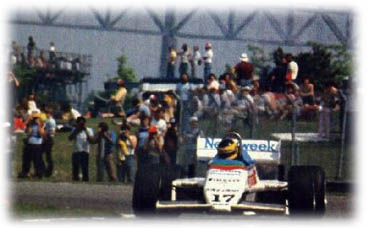 In a plan similar to that of the British Grand Prix, Mosport Park and Mont Tremblant were to platoon the Canadian Grand Prix. So in 1968, the race moved to the beautiful Quebec mountains. However, the track was as terrible as the scenery was beautiful. The tight, twisty and bumpy circuit rendered a slaughter on the cars, with only seven of them finishing. Jacky Ickx, driving for Ferrari, was both the most fortunate and the least fortunate driver. The Belgian suffered a stuck throttle in practice, crashing heavily and, according to eye witnesses, fortune to survive with only a broken leg. Denny Hulme was again part of a one-two, but this time he was the winner over McLaren teammate Bruce McLaren. In a plan similar to that of the British Grand Prix, Mosport Park and Mont Tremblant were to platoon the Canadian Grand Prix. So in 1968, the race moved to the beautiful Quebec mountains. However, the track was as terrible as the scenery was beautiful. The tight, twisty and bumpy circuit rendered a slaughter on the cars, with only seven of them finishing. Jacky Ickx, driving for Ferrari, was both the most fortunate and the least fortunate driver. The Belgian suffered a stuck throttle in practice, crashing heavily and, according to eye witnesses, fortune to survive with only a broken leg. Denny Hulme was again part of a one-two, but this time he was the winner over McLaren teammate Bruce McLaren.
Back at Mosport Park, the third one-two in a row was achieved in Canada. Jacky Ickx was victorious over Brabham teammate Jack Brabham. The Belgian made it a hat-trick, taking pole and fastest lap along with the win. And as if three one-two's weren't enough, Ferrari made it four in a row at the second outing at Mont Tremblant. Jacky Ickx was again the winner, with Clay Regazzoni finishing second. However, it wasn't an easy win. Jackie Stewart gave the Ferrari's a terrible time when he took pole and then cruised away to a seventeen second lead, before his car broke down.
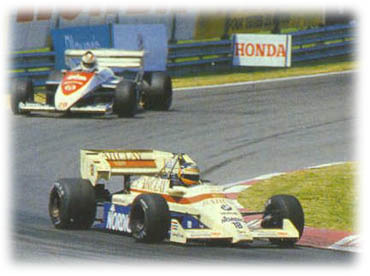 In the following years, Mosport became the sole home of the Canadian Grand Prix. Jackie Stewart turned his luck and won the next two events for Tyrrell. In 1973 the rain made Mosport Park into a chaos. For the first time in Formula One history, a pace car was introduced on the track after the McLaren of Jody Scheckter collided with Fancois Cevert's Tyrrell. The idea was good, but unfortunately the execution was of a much lower level. The pace car held its pace ahead of the wrong driver, allowing Peter Revson to make up nearly an entire lap in his McLaren. When the pace car had gone, Revson smiled and took home the win. In the following years, Mosport became the sole home of the Canadian Grand Prix. Jackie Stewart turned his luck and won the next two events for Tyrrell. In 1973 the rain made Mosport Park into a chaos. For the first time in Formula One history, a pace car was introduced on the track after the McLaren of Jody Scheckter collided with Fancois Cevert's Tyrrell. The idea was good, but unfortunately the execution was of a much lower level. The pace car held its pace ahead of the wrong driver, allowing Peter Revson to make up nearly an entire lap in his McLaren. When the pace car had gone, Revson smiled and took home the win.
After first seeing Mont Tremblant disappear for safety reason, in 1978 Mosport Park was also deemed too dangerous, and the race moved to the brand new semi-street circuit of Montreal. Located around the site of Expo 67, the track had both slow turns and fast straights.
 The first race immediately provided the best result Canada could wish: local hero Gilles Villeneuve scored his first victory in his Ferrari. Four years later, Canada was in mourning, as Gilles Villeneuve had died. Right at the start of the race, a terrible accident happened. Didier Pironi, Ferrari driver and Gilles Villeneuve's teammate at the time of his death, stalled his car on the grid. By a miracle all drivers seemed able to pass him. All, except for one. Osella driver Riccardo Paletti drove into the back of the Ferrari. The unfortunate Italian didn't survive the crash, as his car burst into flames, with the fire marshals unable to extinguish the rapidly spreading fire. The first race immediately provided the best result Canada could wish: local hero Gilles Villeneuve scored his first victory in his Ferrari. Four years later, Canada was in mourning, as Gilles Villeneuve had died. Right at the start of the race, a terrible accident happened. Didier Pironi, Ferrari driver and Gilles Villeneuve's teammate at the time of his death, stalled his car on the grid. By a miracle all drivers seemed able to pass him. All, except for one. Osella driver Riccardo Paletti drove into the back of the Ferrari. The unfortunate Italian didn't survive the crash, as his car burst into flames, with the fire marshals unable to extinguish the rapidly spreading fire.
1989 saw, like Villeneuve eleven years before, another driver take his maiden victory on the Montreal track. Belgian Thierry Boutsen stepped in the footsteps of his countryman Jackie Ickx in a drenched race. Boutsen made it a clear win over his Williams teammate Riccardo Patrese. The following year Gerhard Berger crosses the line first. However, he wasn't the winner. The Austrian was penalised for making a false start and one minute of his time was deducted, subsequently dropping him to fourth, with fellow McLaren driver Ayrton Senna being the new winner.
 In 1991 Nigel Mansell proved once again that sometimes luck can be the most important ingredient in a Grand Prix win. Or lack of it, as the case may be. The Briton lead the race from start till finish. Well, almost till finish. With the chequered flag in sight, absolutely certain his first victory since the 1990 Portuguese Grand Prix is in his reach, Mansell's car broke down - a gearbox failure it would later be revealed. The amazed Mansell - who had a lead of almost a minute prior to that - parked his Williams by the side of the track and watched Benetton's Nelson Piquet score his final victory in Formula One, slong with four other cars passing the finish line, leaving him classified as sixth. In 1991 Nigel Mansell proved once again that sometimes luck can be the most important ingredient in a Grand Prix win. Or lack of it, as the case may be. The Briton lead the race from start till finish. Well, almost till finish. With the chequered flag in sight, absolutely certain his first victory since the 1990 Portuguese Grand Prix is in his reach, Mansell's car broke down - a gearbox failure it would later be revealed. The amazed Mansell - who had a lead of almost a minute prior to that - parked his Williams by the side of the track and watched Benetton's Nelson Piquet score his final victory in Formula One, slong with four other cars passing the finish line, leaving him classified as sixth.
1995 saw the crowd go into complete ecstasy when Frenchman Jean Alesi scored his maiden victory in a Ferrari carrying the legendary number 27, with which Gilles Villeneuve achieved his greatest successes. On his victory lap, Alesi's car ran out of fuel. The victor was then driven into the Parc Ferme on the side of Michael Schumacher's Benetton.
The first major accident after those of Ayrton Senna and Roland Ratzenberger, took place in the Canadian Grand Prix of 1997. After 52 laps, Olivier Panis' Prost suddenly broke away on one of the fastest parts of the track. The Frenchman suffered two broken legs and was sidelined for months. Until this day, Panis has never been as fast as he was before his crash.
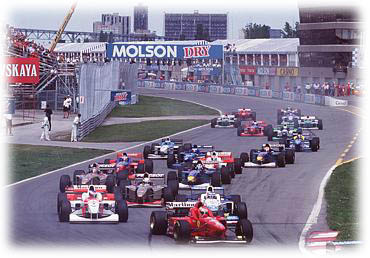 Earlier in the race, Jacques Villeneuve made a mistake when he was coming onto the start-finish straight. Villeneuve, desperate to please the crowd and achieve what his father did before him, admitted it was the most embarrassing moment of his career. Earlier in the race, Jacques Villeneuve made a mistake when he was coming onto the start-finish straight. Villeneuve, desperate to please the crowd and achieve what his father did before him, admitted it was the most embarrassing moment of his career.
Last season provided Formula On fans with more than enough action. At the first start, Alexander Wurz ploughed straight through the field and somersaulted through the gravel, causing a massive havoc. The race was stopped immediately, but the second start provided just as much chaos when Ralf Schumacher, who had stalled his car on the first start, spun. Both Jean Alesi and Jarno Trulli, trying to avoid the German, also spun, with Trulli's Prost parking half on Alesi's Sauber as a result. Unfortunately for both, the organisers decided to put the safety car on the track instead of having another restart.
A short while later the safety car had to come out again, this time after Pedro Diniz has mowed the lawn, leaving grass and mud all over the track. 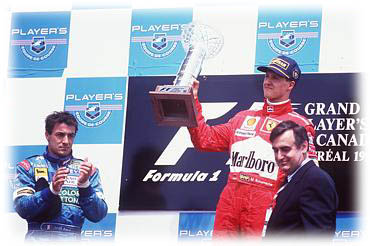 After that, the safety car more or less made a pitstop, coming out again right after going in. This time, Diniz' Arrows teammate Mika Salo was the reason. The Finn had crashed into the barriers, bouncing back over the track. Leader Michael Schumacher then made use of the safety car situation, by making an early pitstop. While coming out of the pits, the German collided with countryman Heinz-Harald Frentzen, whose Williams was thrown off the track. Schumacher was given a 10-seconds stop-go penalty for that, but even that was not enough to keep him from cruising the rest of the race to victory, in front of Giancarlo Fisichella (Benetton) and his Ferrari teammate Eddie Irvine. After that, the safety car more or less made a pitstop, coming out again right after going in. This time, Diniz' Arrows teammate Mika Salo was the reason. The Finn had crashed into the barriers, bouncing back over the track. Leader Michael Schumacher then made use of the safety car situation, by making an early pitstop. While coming out of the pits, the German collided with countryman Heinz-Harald Frentzen, whose Williams was thrown off the track. Schumacher was given a 10-seconds stop-go penalty for that, but even that was not enough to keep him from cruising the rest of the race to victory, in front of Giancarlo Fisichella (Benetton) and his Ferrari teammate Eddie Irvine.
Canada - Just the Facts
This is the 31st Canadian Grand Prix to take place and the 21st Grand Prix on the circuit Gilles Villeneuve, which is the third venue for the race. The first Canadian Grand Prix took place on the Mosport Park circuit near Toronto in Ontario in 1967, alternating with the Mont Tremblant track near Montreal for the first four years of its existence.
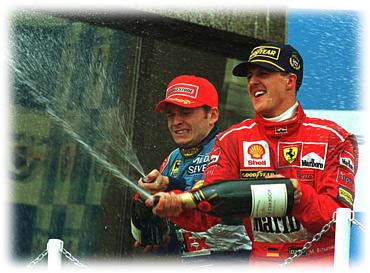 Ferrari and McLaren have each won in Canada seven times. Ferrari's last win was last year, in 1998; McLaren's was in 1992. Williams have won the Canadian Grand Prix six times, but have had three 1-2 finishes - in '80, '89 and '96 while McLaren have had two, in '68 and '88, as have Ferrari - in '70 and '85. Williams have occupied the front row three times, and McLaren four. Ferrari has never managed it.
Most successful drivers in Canada have been Nelson Piquet and Michael Schumacher who have each won three times. Piquet led from start to finish from pole position and taking fastest lap in '84 while Michael Schumacher did the same thing in '94. Piquet scored Pirelli's last win driving for Benetton in 1991; it was also his own last win.
Jackie Stewart - who celebrates his 60th birthday on the Friday of this year's event - scored Tyrrell's first ever pole position on its very first race in Canada in 1970. The 1973 race was his 99th and final Grand Prix.
The 1980 Canadian Grand Prix, which was the penultimate race of the year because it used to feature later in the season, was the venue for Alan Jones to clinch his World Championship title.
The Canadian Grand Prix was the first race to be stopped because of rain, in 1971 after 64 of the 80 laps. It was stopped again in 1980 because of a startline accident and again in 1981 because of rain at the two hour mark. Another startline accident caused the race to be stopped the following year. Mike Thackwell was unable to take the restart in the 1980 race but even so, some people consider him still to be the youngest ever driver to start a Grand Prix at 19 years and 182 days. These days he's a teacher in Guildford, England.
There has been a rash of stoppages recently, too. The race was stopped a lap early in 1995 due to spectators on the circuit. Olivier Panis' accident caused an early stoppage in 1997 and a first corner accident caused a stoppage last year. The 1973 race also has the dubious honour of being the first Grand Prix to be controlled by a safety car.
Apart from Stewart's birthday, don't forget Jean Alesi's on the 11th, while it should be David Coulthard's and Olivier Panis's 80th Grand Prix and Luca Badoer's 40th.
Mika Hakkinen could score his sixth successive pole this weekend; that feat has already been achieved by Senna (twice), Moss, Lauda and Mansell, but Senna has had seven and eight successive poles and Prost has also had seven.
|








